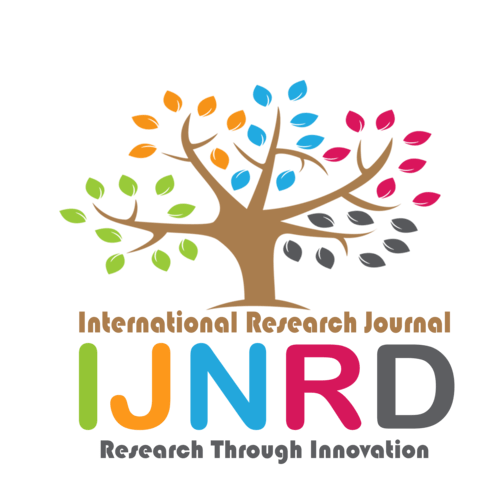|
|||||||||||||||

|
INTERNATIONAL JOURNAL OF NOVEL RESEARCH AND DEVELOPMENT International Peer Reviewed & Refereed Journals, Open Access Journal ISSN Approved Journal No: 2456-4184 | Impact factor: 8.76 | ESTD Year: 2016 Scholarly open access journals, Peer-reviewed, and Refereed Journals, Impact factor 8.76 (Calculate by google scholar and Semantic Scholar | AI-Powered Research Tool) , Multidisciplinary, Monthly, Indexing in all major database & Metadata, Citation Generator, Digital Object Identifier(DOI) |
||||||||||||||
Issue: May 2024
Volume 9 | Issue 5
Review Result and Publication of Paper within : 2-3 days
Click Here For more DetailsFor Authors
Forms / Download
Published Issue Details
Editorial Board
Other IMP Links
Facts & Figure
Impact Factor : 8.76
Issue per Year : 12
Volume Published : 9
Issue Published : 96
Article Submitted :
Article Published :
Total Authors :
Total Reviewer :
Total Countries :
Indexing Partner
Join RMS/Earn 300
Licence
This work is licensed under a Creative Commons Attribution-NonCommercial 4.0 International License







|
Published Paper Details
|
|
| Paper Title: | Impact of Chemical Contamination on surface and groundwater Resources in Sub-Himsalayas and Lesser-Himalayas through rock and soil Leachates and untreated Waste Disposal in Water: A Case Study. |
| Authors Name: | muhammad arshad khan , Azka AK , Areena AK , Lyabha Abid |
| Download E-Certificate: | Download |
| Author Reg. ID: |
IJNRD_213039
|
| Published Paper Id: | IJNRD2401303 |
| Published In: | Volume 9 Issue 1, January-2024 |
| DOI: | |
| Abstract: | Abstract: The contamination sources in Sub-Himalayas and Lesser-Himalayas are landfill leachates , waste disposal from hospitals, sewage from hospitals, homes, cities, leakages from under ground septic tanks, waste material dumped on ground surface, chemicals from agriculture, pesticides, effluent from chemical industries, the soils and rocks. The main source of river water is melting of glaciers on mountains. The second source is rain water. The rain water percolate in soil and get excess to aquifer. People get this water for drinking through springs. The water coming through rocks leach chemical [hazardous toxic ]elements and absorb gases , like Ca, Mg, K, Na, CU, Pb, Mn, CU, Zn, Hg, Ar, SO4, CO3, NO3, NO2, CO2. and contaminate drinking water. Similarly, the water coming from soil as springs is used for drinking. Alternate sources are ponds, lakes and rivers. Contamination of water is an international problem. As a case study 500 water samples were collected from springs, Nalas, lakes, ponds, rivers, rock and soil leachates and tested for routine and toxic hazardous elements. The leachates contamination is a big risk for health. The toxic elements move to ground water and contaminate surface water. The samples collected were analyzed for chemical contamination of water in Himalayas. In addition more than 100 patients were selected for blood tests and 1000 reports were thoroughly investigated for water borne diseases. It was found that in those areas where water is contaminated, 15% patients get cancer, 25% heart diseases, 20% stomach pains, 10% neurological problems, 40% bone diseases, 10 % intestine injuries, 20 % neurological system failure. The parasite giardia lamblia, identified in 30% cases. Viral in 15%, bacterium E-Coli in 7%. In the outbreak of E-Coli 40 % peoples were hospitalized and 20 % died. Five hundred people were ill with severe intestinel distress, other flue like symptoms, weakness, aches, and pain. At least 4000 people were died from 2012-2021. More were HIV positive. The disease was treated as cryptosporidium. The chemical and microbiological agents adversely affecting the quality of ground and surface water. Waste disposal from hospitals, land applications, animal wastes, septic tanks, sewage, organic wastes, toxic hazardous wastes leachates and petroleum products affect water quality in the area of study. Chemical contamination in stream water and spring water exceeds the recommend limits. The WHO Guidelines [ 2001-2021]. Guidelines for water are Cd < 0.03 mg/l, Hg 0.001 mg/l, Pb < 0.01 mg/l, As < 0.01 mg/l, Cr < 0.05 mg/l, CN < 0.07 mg/l, NO3,NO2 <50 mg/l, Zn < 5 mg/l, CU < 1 MG/L, Cl < 250 mg/l. The chemical values in Azad Kashmir and Punjab Pakistan are higher than recommended values. |
| Keywords: | |
| Cite Article: | "Impact of Chemical Contamination on surface and groundwater Resources in Sub-Himsalayas and Lesser-Himalayas through rock and soil Leachates and untreated Waste Disposal in Water: A Case Study.", International Journal of Novel Research and Development (www.ijnrd.org), ISSN:2456-4184, Vol.9, Issue 1, page no.d17-d27, January-2024, Available :http://www.ijnrd.org/papers/IJNRD2401303.pdf |
| Downloads: | 000118753 |
| ISSN: |
2456-4184 | IMPACT FACTOR: 8.76 Calculated By Google Scholar| ESTD YEAR: 2016 An International Scholarly Open Access Journal, Peer-Reviewed, Refereed Journal Impact Factor 8.76 Calculate by Google Scholar and Semantic Scholar | AI-Powered Research Tool, Multidisciplinary, Monthly, Multilanguage Journal Indexing in All Major Database & Metadata, Citation Generator |
| Publication Details: |
Published Paper ID:IJNRD2401303 Registration ID: 213039 Published In: Volume 9 Issue 1, January-2024 DOI (Digital Object Identifier): Page No: d17-d27 Country: rawalpindi, Azad Kashmir, Pakistan Research Area: Health Science Publisher : IJ Publication Published Paper URL : https://www.ijnrd.org/viewpaperforall?paper=IJNRD2401303 Published Paper PDF: https://www.ijnrd.org/papers/IJNRD2401303 |
| Share Article: | |
|
Click Here to Download This Article |
|
| Article Preview | |
|
|
|
Major Indexing from www.ijnrd.org
| Semantic Scholar | Microsaoft Academic | ORCID | Zenodo |
| Google Scholar | ResearcherID Thomson Reuters | Mendeley : reference manager | Academia.edu |
| arXiv.org : cornell university library | Research Gate | CiteSeerX | PUBLON |
| DRJI | SSRN | Scribd | DocStoc |
ISSN Details
 |
 |
ISSN: 2456-4184
Impact Factor: 8.76 and ISSN APPROVED
Journal Starting Year (ESTD) : 2016
DOI (A digital object identifier)
Conference
Open Access License Policy
Important Details
Social Media
| Copyright © 2024 - All Rights Reserved - IJNRD |












Facebook Twitter Instagram LinkedIn